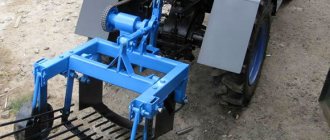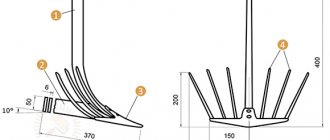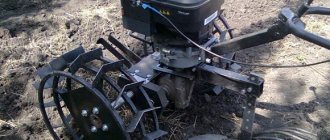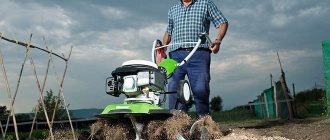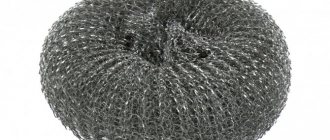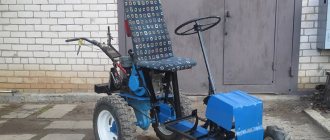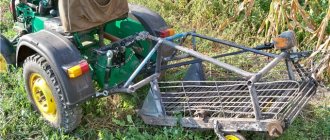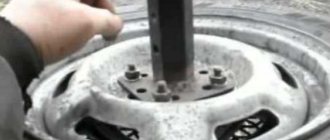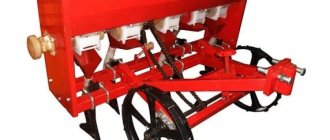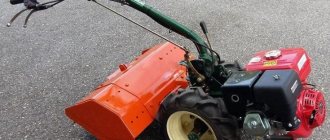The potato digger for the Neva walk-behind tractor is an attachment that allows you to harvest crops from land as quickly, efficiently and efficiently as possible.
More recently, mechanized harvesting was carried out only by large agricultural enterprises. Now even small farmers are trying to speed up and simplify this process. Having walk-behind tractors or mini tractors at their disposal, farmers are thinking about purchasing additional mechanisms for them that reduce physical labor and increase productivity. The modern market is represented by a large assortment of mounted agricultural equipment, such as:
- planters;
- diggers;
- hillers;
- mowers
This review will examine the main models of potato diggers for the Neva walk-behind tractor, their characteristics and operating principles.
Drum potato diggers
This is a rather rare type of equipment for mini-equipment, so it is mostly homemade. Peeling potatoes from soil in such devices occurs quite efficiently, as does laying them on the ground, but the design itself is quite controversial, and the tubers are more damaged than when digging with the above-mentioned potato diggers, and therefore are worse preserved.
What is simpler about them is the direct drive of rotation from the power take-off shaft. Everything else: making the drum, thrust rollers and bearings is clearly more complicated. The design of the knife does not have any special features, except that it is preferable for it to have a more rounded shape in the back so that the potatoes are not further damaged when they get into the drum.
Conveyor potato diggers
They are much easier to make yourself, but in our opinion they are no worse at peeling potatoes from soil.
Their knives are the same as those of the screening ones, and the potatoes are peeled while they move along the conveyor belt. It is clear that the longer it is, the better the potatoes will be peeled, but long conveyor belts can only be installed on potato diggers used with tractors. On walk-behind tractors, they will interfere with the person walking behind him.
The conveyor belt drive may be different. If it is taken from the wheels of the digger itself, then they must have good lugs so that they do not lock on wet or very loose soil.
Also interesting in this design are the rear guides, which more compactly place the potatoes behind the belt.
In this self-assembled conveyor potato digger, the belt drive is carried out from the power take-off shaft of a homemade walk-behind tractor
and is transmitted by a motorcycle chain.
To view a picture, click on its thumbnail on the right
When manufacturing a potato digger of this type, the main problem will be selecting the rotation speed of the conveyor drive gear and matching it with the speed of the power take-off shaft. In this model, the power take-off shaft rotates at a speed of 500 - 800 rpm, and the gearbox is taken from a motor boat with a gear ratio of approximately 1:2. The rest is selected by the size of the stars for an approximate walking speed when digging 2-3 km/h.
And yet, the connection between the speed of the conveyor belt and the wheel speed seems more appropriate to us.
There are models designed for specific walk-behind tractors and mini tractors, like this one for mechanisms with a side power take-off shaft:
Potato diggers with a roar
This is the most common type of potato digger, produced by various machine-building plants in Russia and abroad. It has slight design differences, primarily in the design of the screen drive - oscillating during operation of the pan, which allows the potatoes to be partially cleared of the soil while the potato digger is moving.
The knife of such a digger can have different configurations. It can be fixed motionless, or it can be hinged and oscillate slightly during movement, simplifying the process of digging up tubers. The width of the knife is 35 – 40 cm.
Fan potato diggers
The simplest ones to manufacture are also produced industrially, but most require some modifications.
It is immediately clear that they are based on the same hiller; it is this hiller, buried below the level of the tubers, that loosens and turns the soil. But he brings up the dug potatoes - a fan welded to the back of the hiller. Its role is played by metal rods, welded at a distance of 3–4 cm from each other, diverging and curved in the upper part.
READ What kind of oil is in the gearbox of a walk-behind tractor?
The amount of depth is regulated by thrust wheels, and the transverse bar serves as a footrest, upon which a person, with his weight, provides the required depth to the device.
It is this type of fan potato digger that seems to us to be the most productive. The digging process itself can be seen here:
Below is an approximate drawing of such a potato digger, containing the main parameters for manufacturing.
You will have to modify the shape, angle of attack and other nuances yourself, taking into account your soil, the power and driving performance of the walk-behind tractor on which you plan to install the potato digger, and even the varieties of potatoes that form tubers at different depths.
A type of similar digger without a fan, designed for two people:
Popular models
There are various brands of attachments for digging potatoes on sale. From this list we can select the most popular models of units.
CHAMPION C3000
Budget fan-type potato digger, compatible with Champion series 5-8 cultivators. It has a length of 41 cm, a width of 33 cm and a height of 10 cm. The weight of the unit is 2.9 kg. The body is made of metal and coated with powder paint. The amount of depth is set by changing the holes used in the rack and hitch bracket. A rear hitch can be additionally purchased for the digger, in the price range from 285 to 1030 rubles. The cost of the equipment itself is only 730 rubles.
HUTER universal for MK, GMC
Equipment for mechanically extracting potato tubers, cleaning them from soil and laying them on the ground for manual collection. It is also possible to process beets, carrots, onions, and garlic. The depth level is adjusted, and the hitch is used to connect to the equipment. The unit is compatible with almost any type of cultivator and walk-behind tractor. Price 875 rub.
VRMZ 03.03.21.00.00
Russian potato digger with a working width of 23-39 cm and a depth of 25 cm. The hitch is not included. The metal unit is used for harvesting potatoes, beets and other similar root crops. Size (LxWxH) 56x23x50 cm, weight – 6 kg. The cost of the canopy is 1636 rubles.
VRMZ T 12.03.51.00.00
The excavator for walk-behind tractors from Tarpan is characterized by high strength, reliability and a long service life. Dimensions (LxWxH) are 43x43.4x50 cm, weight is 4.7 kg. Price 1140 rub.
S-mash without hitch, reinforced
A device with amplification, suitable for Neva, Cascade and Oka walk-behind tractors. To connect, you need to buy a universal hitch, as well as lugs that provide more convenient operation of the unit. Dimensions (LxWxH) are 60x50x40 cm. Case material is high quality metal. The unit is suitable for digging potatoes and other root vegetables. Price 1211 rub.
Potato digger for walk-behind tractor, types of designs, drawings for making it yourself
The bulk of Russians' garden space is traditionally allocated to potatoes, because our people also call it the second loaf. Many have transferred part of the labor of growing potatoes onto their shoulders, or rather onto trailed small-scale mechanization equipment: walk-behind tractors and mini tractors.
And if planting potatoes is not a big job, then hilling them, and most importantly, digging them up is not an easy task. For hilling and weeding, the hiller included with walk-behind tractors is most often used, but for digging in its pure form it is not entirely suitable. Let's figure out what to dig and how to make a potato digger for a walk-behind tractor with your own hands.
There are several known designs of potato diggers for walk-behind tractors and mini tractors. Let's look at them: from the simplest to the most technologically advanced.
How to set up a potato digger on a Neva walk-behind tractor
The potato fan digger does not require complex settings; it is attached to the walk-behind tractor using a single universal hitch and moves behind the walk-behind tractor, going deep to a certain depth.
To set up a screen-type potato digger, you must carefully study the operating instructions to ensure proper assembly of the device. To connect the equipment to the Neva walk-behind tractor, you must use a coupling device.
- Connect the digger to the walk-behind tractor, tighten the mounting bolts.
- Make sure that the nuts and locking bolts of the device components are properly tightened.
- Place the belt on the machine and attachment pulleys.
- Check the serviceability of the tensioner and the hinge joints for the presence of grease.
The adjustment is carried out as follows:
- First of all, it is necessary to align the pulleys of the walk-behind tractor and the potato digger in parallel. This can be achieved by rotating the nuts of the thrust bolts.
- Next, the digging depth is adjusted - the plowshares should enter the soil below the location of the root crops. Typically the depth is set in the range from 12 to 15 cm. Adjustment is carried out using the hitch bracket and support wheels. If the depth is set too large, the machine's performance will decrease due to increased resistance, and fuel consumption will increase. If the depth is less than 12 cm, the risk of tuber damage increases.
The conveyor digger can be adjusted after a test run with the attachment connected. To do this, you need to rotate the adjusting screw, selecting the desired angle of attack. Holes are also selected on the trailer unit and the frame of the device to achieve the most suitable position. To avoid distortions during operation, it is necessary to adjust the bolts of the towed unit so that the devices are on the same axis.
DIY drawings
It is this type of potato digger, despite being quite difficult to manufacture, that is made by home craftsmen with their own hands more often than others. We offer indicative drawings with the main dimensions of such a potato digger for a walk-behind tractor
.
A large number of joints of moving parts makes this device regularly serviced, but the result of its work is of better quality than that of fan-shaped potato diggers:
Potatoes are peeled better from the ground and are located on its surface.
The magnitude and frequency of oscillations of the screen may vary and depend on the design of the drive, but even with minor oscillations, cleaning occurs quite well:
Types of potato diggers
Regardless of the type, the main function of the device is to loosen the soil under the bushes and transport strawberries to the surface. Using such a device requires minimal physical effort, since the crop can be easily collected from the surface of the ground.
Types of potato diggers for walk-behind tractors: fan, screen and conveyor
The following types of potato diggers are suitable for self-production:
- Simple (including fan): they are a small plow with rods through which excess soil is sifted, and the tubers remain on the surface.
- Vibrating (screening) machines have a ploughshare and one or more gratings that rest on wheels. The ploughshare loosens the soil, and the soil, tubers and tops fall on the grid, are sifted, and the potatoes remain on the surface of the bed.
- Conveyor (single-row) – one of the most difficult options. They are equipped with a ploughshare and a conveyor belt onto which soil with tubers falls. This type of tool is most suitable for heavy soils.
Let's take a closer look at the features of each type and provide useful information about making them yourself.
Horse-mounted potato digger
There are still quite a lot of them for sale on the Internet. They are imported mainly from Poland and converted into mini tractors and walk-behind tractors.
At the same time, taking into account the higher speed of movement of this equipment in comparison with a horse, in addition to modifying the towing device, a limiter-shield is placed on it on the side on which the dug potatoes are thrown. Otherwise, it will have to be collected in neighboring areas. A wedge-shaped paw digs up the potatoes, as in fan diggers, and the drive of the device that removes the tubers from the ground is carried out by wheels with lugs. The higher the travel speed, the faster this potato extractor rotates.
Dear readers, if you have any questions, please ask them using the form below. We will be glad to communicate with you
